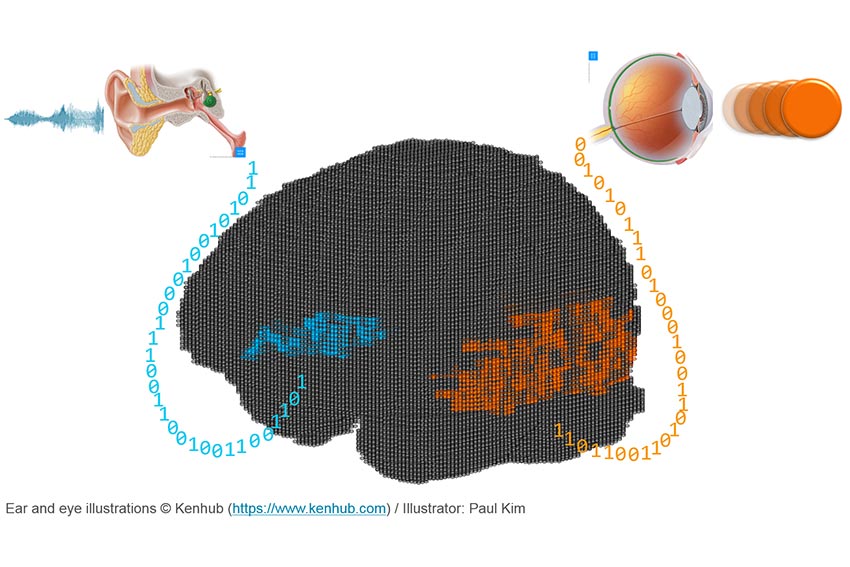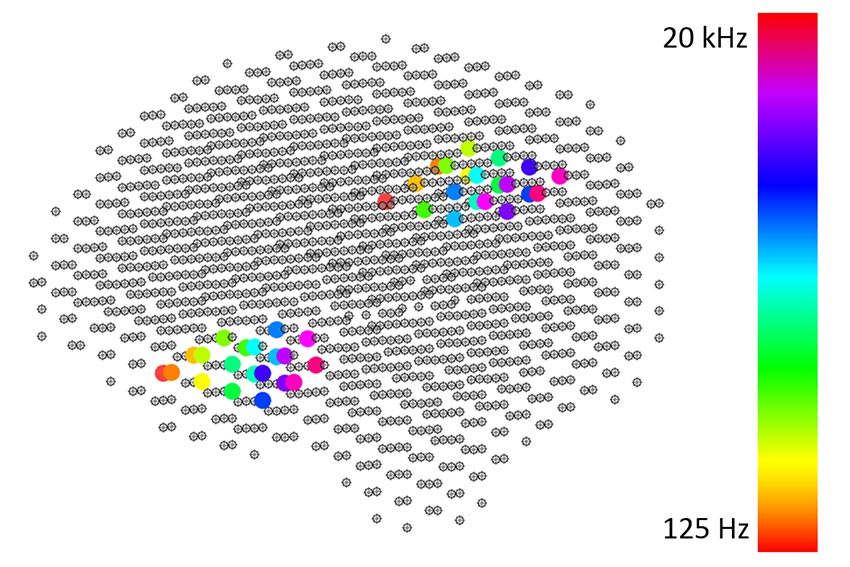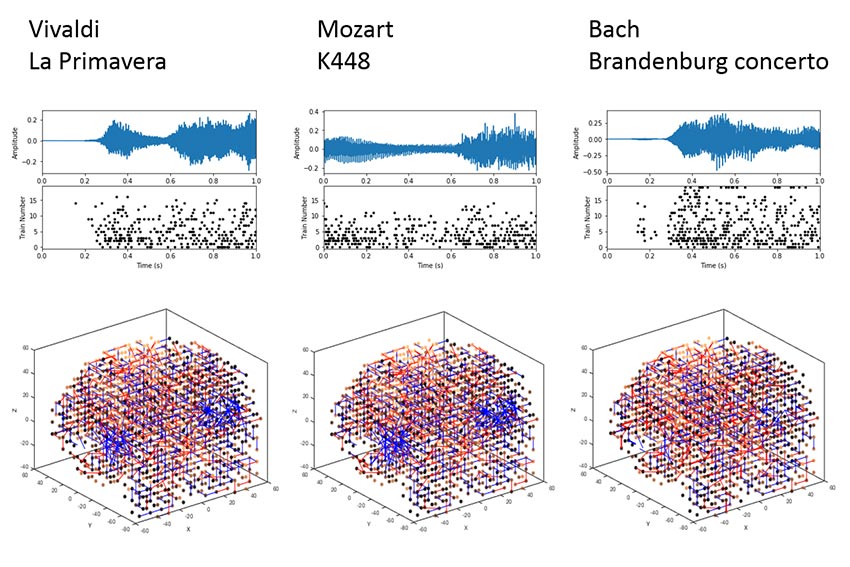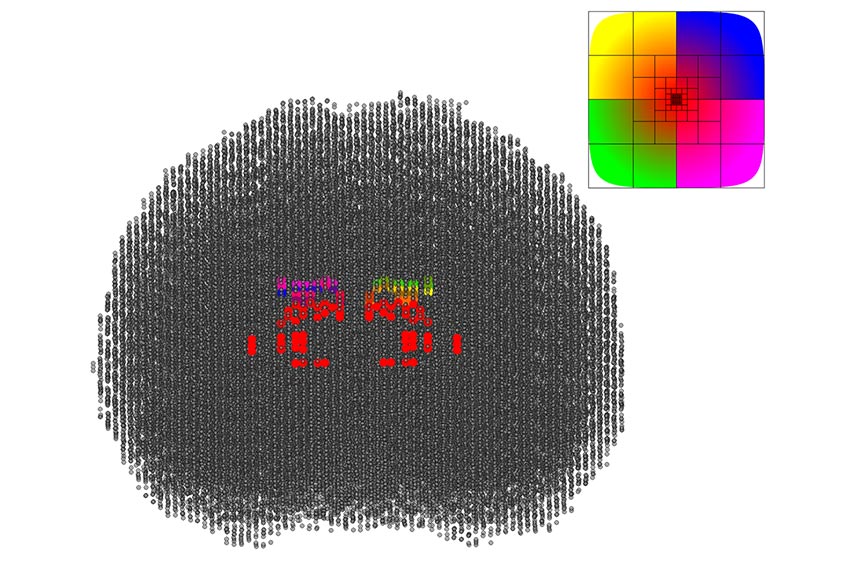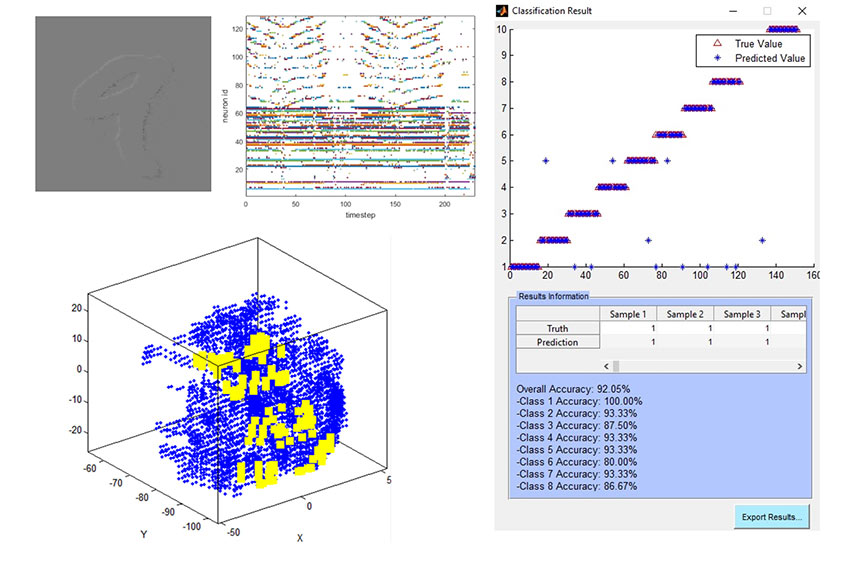Study of Creativity
The Study of Creativity Group is developing new methods and systems for audio-visual information processing, for concept formation, learning languages and Virtual Reality visualisation for the data and process understanding.
This is a collaboration between KEDRI, AUT's creative technologies team and the AUT Sentience Lab.
Current projects
The lab is working on several projects, including:
Recent development in artificial neural networks has led to an increase in performance, but also in complexity and size. This poses a significant challenge for the exploration and analysis of the spatial structure and temporal behaviour of such networks. Several projects for the 3D visualisation of neural networks exist, but they focus largely on the exploration of the spatial structure alone, and are using standard 2D screens as output and mouse and keyboard as input devices. NeuVis is a framework for an intuitive and immersive 3D visualisation of spiking neural networks in virtual reality, allowing for a larger variety of input and output devices. It is a core component of NeuCube, a 3-dimensional spiking neural network learning framework, significantly improving the user’s abilities to explore, analyse, and also debug the network.
Overview and usage
The virtual reality project called NeuVis is a specialised 3D visualisation system for NeuCube that harnesses the strength of modern computer graphics hardware and software to allow the user to naturally explore the spatial distribution of neurons and connections, as well as observing and controlling spiking activity in real-time.
This system can be used for:
- Online EEG data visualisation
- Offline EEG data visualisation
- Cognitive games
- Brain Computer Interfaces
- Seismic and earthquake visualisation in a real time
- Visualisation of many other computational systems for the sake of data and process understanding
Related Papers and Benchmarking
The proposed methods and systems offer the following advantages:
- NeuVis is a flexible and scalable framework
- It allows for a range of input and output device combinations
- It integrates a large variety of analysis tools that are helpful in gaining insights to NeuCube that were not possible with the previous visualisation tool
- Combined with a motion capture setup with stereoscopic rendering, NeuVis offers an improved spatial perception that makes navigation as intuitive as moving the user’s own head and body
See also some of the related papers:
- Marks, S. (2016). Immersive visualisation of 3-dimensional spiking neural networks. Evolving Systems, 1-9. doi:10.1007/s12530-016-9170-8
- Kasabov, N., Scott, N. M., Tu, E., Marks, S., Sengupta, N., Capecci, E., Othman, M., Gholoami Doborjeh, M., Murli, N., Hartono, R., Espinosa-Ramos, J. I., Zhou, L., Alvi, F., Wang, G., Taylor, D., Feigin, V., Gulyaev, S., Mahmoud, M., Hou, Z. G., Yang, J. (2016). Evolving spatio-temporal data machines based on the NeuCube neuromorphic framework: design methodology and selected applications. Neural Networks, 78, 1-14.
- Marks, S., Estevez, J., & Scott, N. (2015). Immersive Visualisation of 3-Dimensional Neural Network Structures. In 13th International Conference on Neuro-Computing and Evolving Intelligence (NCEI) 2015. Auckland. Retrieved from NCEI15
- Marks, S., Estevez, J. E., & Connor, A. M. (2014). Towards the Holodeck: Fully Immersive Virtual Reality Visualisation of Scientific and Engineering Data. In 29th International Conference on Image and Vision Computing New Zealand (IVCNZ) 2014 (pp. 42-47). Hamilton, New Zealand: ACM. doi:10.1145/2683405.2683424
R&D system
For this project, an R&D system has been developed based on NeuCube. The system can be obtained subject to licensing agreement.
Developers
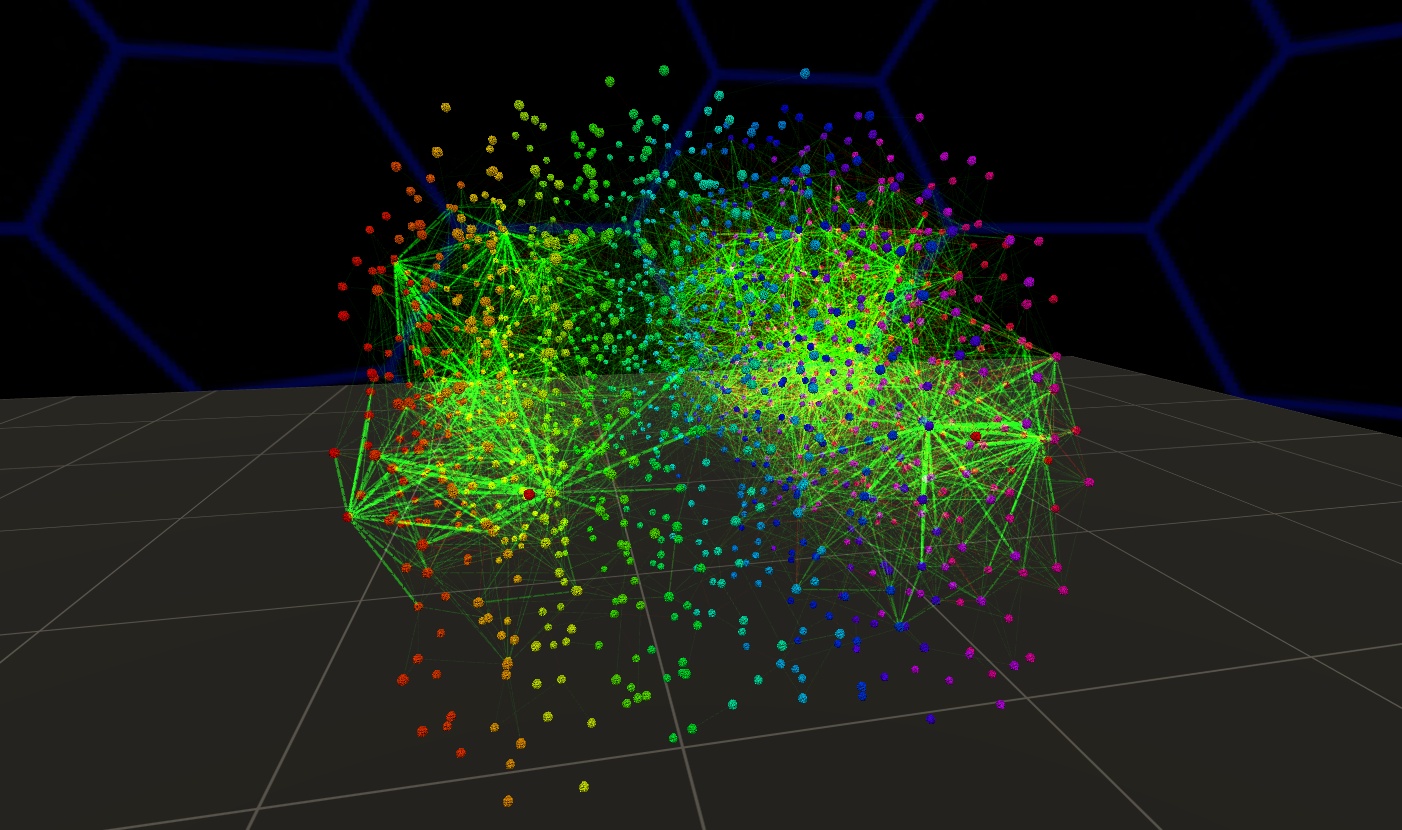
The NeuVis 3D framework.
The NeuCube is used to develop a system that can process audio-visual information in a brain-like way, to explore if the spiking neural network can create conceptual representations of the input provided.
The Brain-Like Artificial Intelligence (BLAI) is pioneered by Prof Nikola Kasabov and here it is applied to a specific application.
This project develops novel methods and systems that are based on the NeuCube SNN brain-like architecture, for:
- Audio data processing - pattern recognition, modelling, prediction, understanding, such as: music, speech, or any types of sounds;
- Visual information processing using the DVS input device for video encoding into spikes, and consecutive learning in a specialised NeuCube model for: pattern recognition, modelling, prediction, and understanding;
- Integrated multi-modal audio-visual information processing: pattern recognition, modelling, concept formation, understanding, and language modelling.
Efficient multimodal audio-visual information processing is still a challenge for Information Sciences, and the human brain is the most efficient machine that achieves this. Understanding the functioning of the brain and its processes, and utilising this for the creation of more sophisticated intelligent systems, have been challenging tasks and an ongoing focus of research in both neurophysiology and artificial intelligence (AI). Recent advancements in computer science have led to the emergence of brain-inspired computing paradigms that can support the analysis of these processes due to their similarity to the real brain. This study aims to create a three-dimensional, spatio-temporal brain-like model of integrated audio-visual information processing using the NeuCube spiking neural network (SNN) architecture. The model will utilise principles of how the brain perceives information through auditory and visual pathways for object recognition in order to investigate the formation of semantic concepts. Based on previous research, which has shown that brain-inspired evolving systems can handle multi-modal input very well, this study was designed to use a biologically realistic brain template with up to two million neurons to compute and simulate neural behavior. The auditory and visual input stimuli will be transformed into electrical signals (spikes) using artificial cochlear and retinal simulation software and possibly devices, and they will be entered into their corresponding processing areas in the brain. It is hoped that such a system can be beneficial in the search for new AI technologies for human-computer interaction, along with a better understanding of the multimodal audio-visual information processing and concept formation in the human brain.
Learning the auditory characteristics of classical music
Music has been a vital part of mankind for centuries, expressing cultural, emotional, and spiritual aspects of life. The human brain can memorise and recall musical pieces by learning the dynamic, characteristic patterns of soundwaves through its auditory pathway and related brain areas. In this study, we tried to understand these patterns by creating a computer model that simulates the processes in the inner ear and the auditory cortex, using the NeuCube Deep Spiking Neural Network software architecture. We applied this model to three pieces of classical music by Mozart, Vivaldi, and Bach, and found that there were distinct differences between the neural connections created in each network. Furthermore, when taking 0.5 second-long samples of the music, our model could identify with 97.43% accuracy to which of the three pieces it belonged. Our research suggests that brain-like models can outperform the human brain in terms of music memorisation and recognition.
Learning the visual characteristics of written digits
Vision is a vital sense for humans when interacting with and understanding their environment. The human brain can interpret and memorise visual cues from our surroundings by learning the dynamic, characteristic patterns of lightwaves through its visual pathway and related brain areas. In this study, we tried to understand these patterns by creating a computer model that simulates the processes in the retina and the visual cortex, using the NeuCube Deep Spiking Neural Network software architecture. We applied this model to a dataset of written digits and achieved 92.05% accuracy when replicating the experimental setup of previous studies. Our model outperforms previous results and suggests that brain-like models have an advantage over established computational methods for visual processing tasks.
- Yousefzadeh, A., Serrano-Gotarredona, T., & Linares-Barranco, B. (n.d.). MNIST-DVS and FLASH-MNIST-DVS Databases. Retrieved August 27, 2017, from http://www2.imse-cnm.csic.es/caviar/MNISTDVS.html
- Zhao, B., Ding, R., Chen, S., Linares-Barranco, B., & Tang, H. (2015). Feedforward categorization on AER motion events using cortex-like features in a spiking neural network. IEEE transactions on neural networks and learning systems, 26(9), 1963-1978.
- Henderson, J. A., Gibson, T. A., & Wiles, J. (2015). Spike event based learning in neural networks. arXiv preprint arXiv:1502.05777.
Related papers and benchmarking
The proposed methods and systems showed superior results in the following aspects:
- Better data analysis and classification/regression accuracy (see table below);
- Better visualisation of the created models, with a possible use of VR;
- Better understanding of the data and the processes that are measured;
- Enabling new information and knowledge discovery through meaningful interpretation of the models.
Measure | Henderson et al., 2015 | Zhao et al., 2015 | NeuCube |
|---|---|---|---|
NetworkType | Feed-forward SNN | Composite system, including convolution, feature spike conversion, motion detector, and SNN classifier | Composite system, including bio-inspired spike encoding algorithm, and retinotopic mapping into a brain-like SNN for learning and classification |
Learning Algorithm | A new scheme for spike based learning | Tempotron learning | STDP learning |
Train test ratio | 90-10random selection | 90-10random selection | 90-1010-fold cross validation |
Accuracy (%) | 87 | 88 | 92 |
See also some of the related papers:
- Kasabov, N. K. (2014). NeuCube: A spiking neural network architecture for mapping, learning and understanding of spatio-temporal brain data. Neural Networks, 52, 62-76.
- Kasabov, N., Scott, N. M., Tu, E., Marks, S., Sengupta, N., Capecci, E., Othman, M., Gholoami Doborjeh, M., Murli, N., Hartono, R., Espinosa-Ramos, J. I., Zhou, L., Alvi, F., Wang, G., Taylor, D., Feigin, V., Gulyaev, S., Mahmoud, M., Hou, Z. G., Yang, J. (2016). Evolving spatio-temporal data machines based on the NeuCube neuromorphic framework: design methodology and selected applications. Neural Networks, 78, 1-14.
R&D system
For this project, a R&D system has been developed based on NeuCube. The system can be obtained subject to licensing agreement.
Developers
Our research groups
The research and development work done by KEDRI's founding director, Professor Nikola Kasabov and his team is organised into six areas of research.
